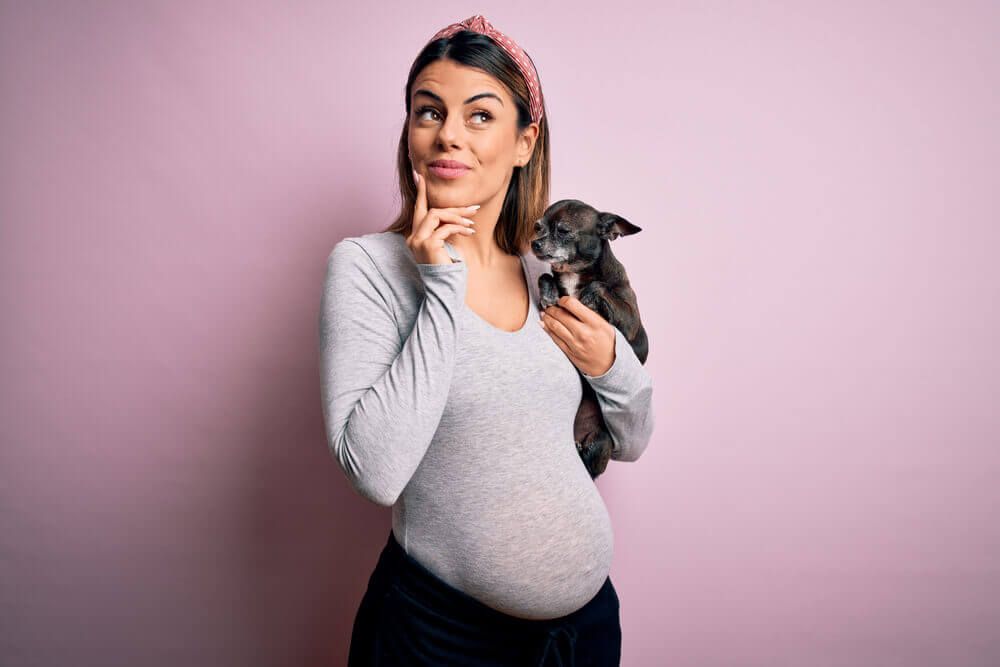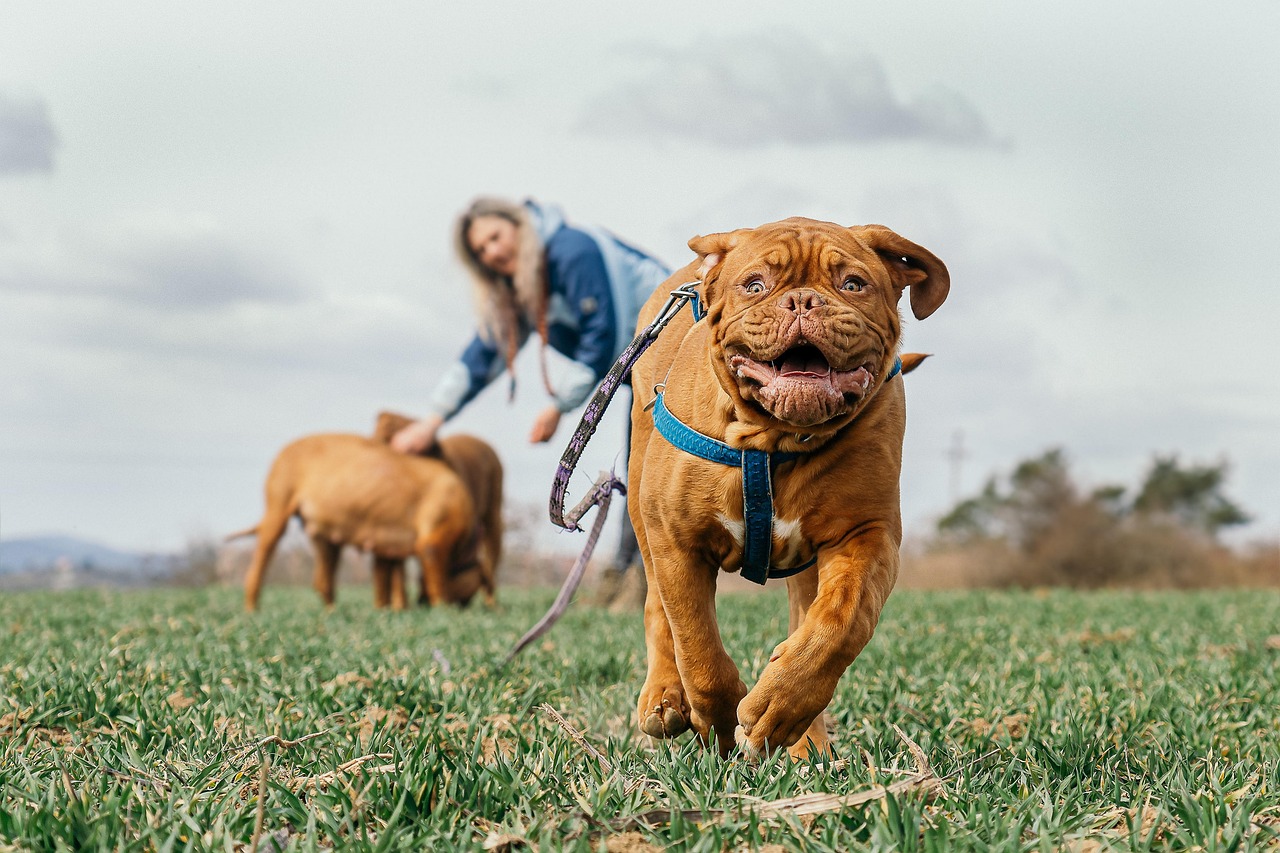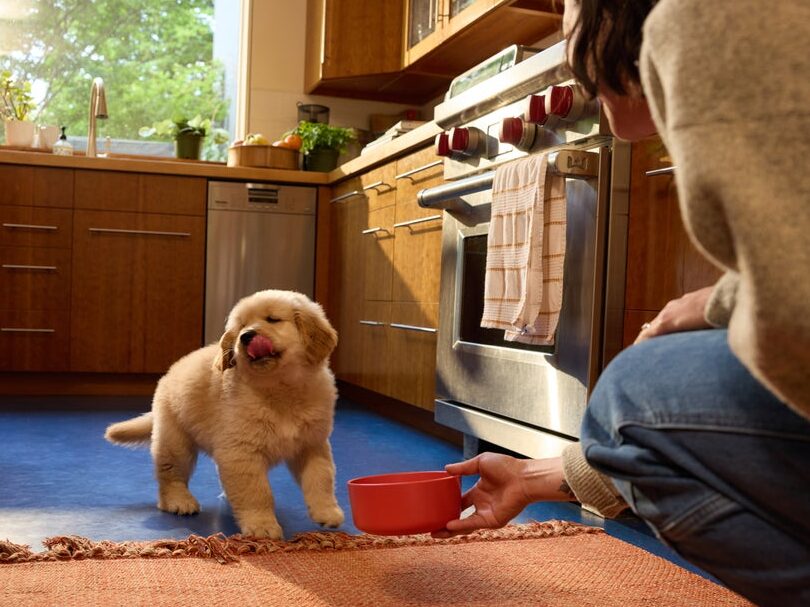Hey Ollie blog readers! We’re offering you an exclusive 60% OFF your starter box! Try now!
You’re expecting and you couldn’t be more excited (or maybe even a little nervous) to bring a new baby into your house. But what about your first baby? If you have a dog you might be unsure of how to help your pup get used to his or her promotion to big brother or sister. We rounded up some of the best tips and tricks to help your new baby settle in and help your pup adjust.
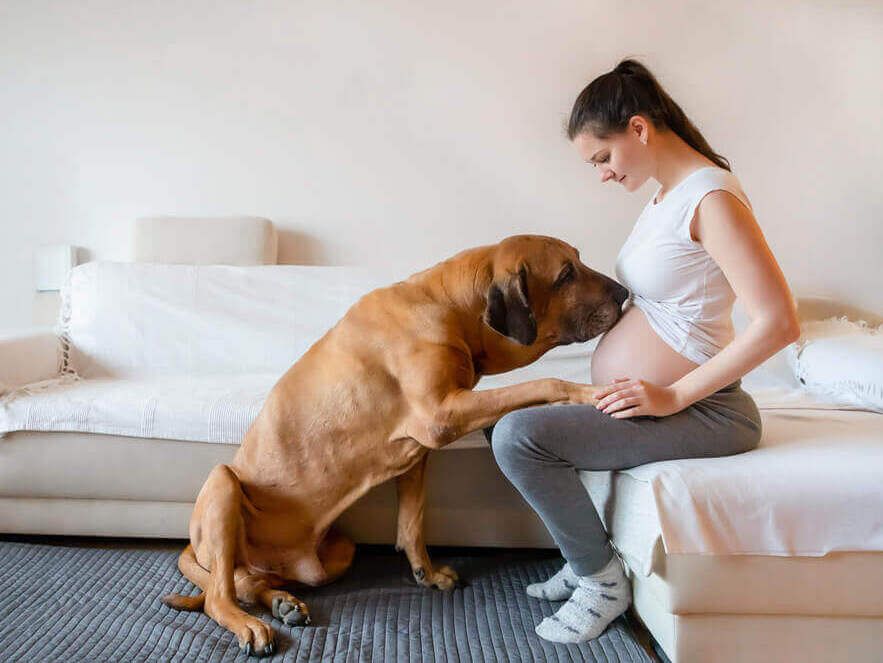
Start preparing your pup before the baby comes
Before the baby comes, you’ll have plenty of baby-related things to do. You’ll need to set up the baby’s room and things for the baby. This may include some new furniture like a crib, changing table, and rocking chair, and some supplies like burp cloths, pacifiers, and diapers. You can involve your pup in this process if it makes sense.
First, decide, will the dog be allowed in the baby’s room. If the answer is yes, you might want to put a bed or place for your pup in there in an appropriate spot. This way, your dog can join you for feedings or changing time and has an appropriate place to be.
You’ll also want to make sure your pup understands that the baby’s things aren’t for them. While it’s okay and totally normal for your dog to be curious about all these presents and packages that are showing up at the house, you don’t want your dog stealing the baby’s toys or pacifiers. Before the baby comes, remember to brush up on important cues like leave it and drop it. That way if you see the dog eyeing something of the baby’s you can remind them to leave it alone. If it’s too late for that, the drop it cue becomes your best friend. Remove the item from your dog’s mouth (or paws) reward them for giving it up and keep it moving!
Before the baby comes brushing up on other obedience cues and teaching your dog to walk with a stroller is a good idea (if you plan to take the dog when you go on walks with the baby). You don’t want behavior issues that aren’t a big deal now to become a challenge when you add the baby. Also, dogs need time to learn and adjust so giving them time to get used to the stroller before the baby comes will make walks more pleasant and safer for everyone involved.
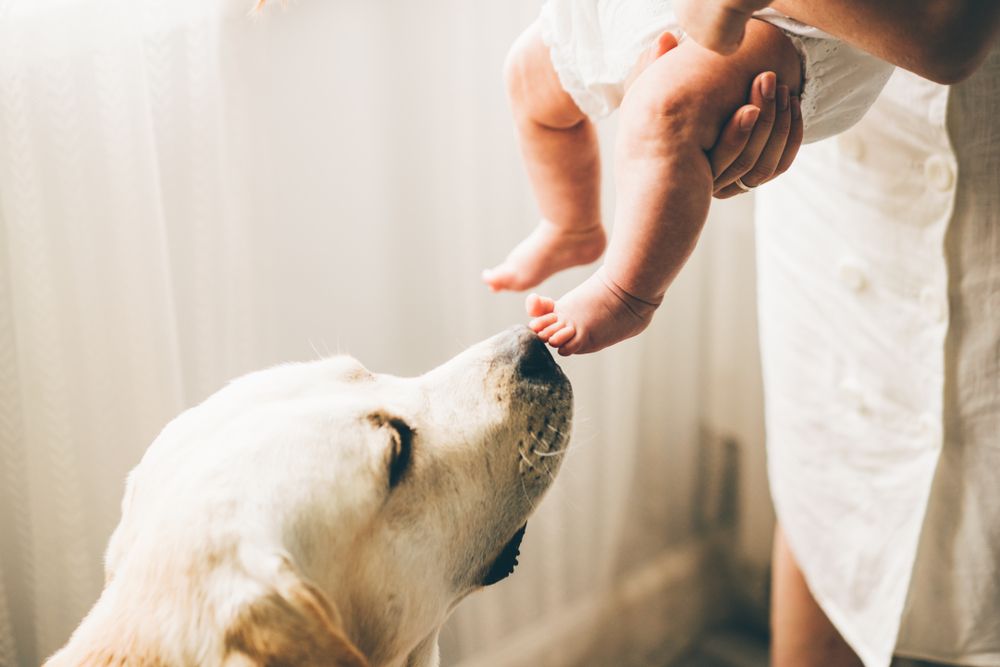
Assess your schedule
Before the baby comes, you want to start thinking about your pup’s current "schedule" and how it might change. For example, if you anticipate not being able to feed and walk him at 6pm, start to shift your schedule now. And if you don’t have a walker, consider getting one at least until you can get your feet back on the ground post-birth.
Rethink your space
Since the layout of your home is bound to change—and furniture switcharoos can cause stress for pups—create a safe, cozy area that’s specifically for your dog where they can escape there (this is especially helpful once the little one is on the move.)
Introduce new sounds
No one wants to listen to a baby wailing longer than they have to, but pups’ ears are particularly sensitive. Introducing them to the sound of crying slowly and at a non-stress-inducing level (through an app like "Baby Sounds") can get them used to it so they don’t freak out when they hear sobbing in the middle of the night.
Teach the cue “Be gentle”
You’ll wind up saying this to your babe once he’s old enough to pet your pup ("Gentle, please!") But in the meantime, try to be patient with your dog and don’t scold him for getting in the way or acting anxious around the baby. And never force an interaction between the two, always let your pup know it’s okay to move away if he clearly doesn’t feel comfortable. Also, like you, a tired or sleep deprieved pup isn’t going to be the most patient. So remember to allow your dog to take a break from interacting with the baby when they need one.
Plan to keep busy
Treat-dispensing and puzzle toys will be your new best friends. Always have one on hand to keep your pup occupied. If your dog likes to chew, ensure someone can supervise while they do. Bones and other chews can be a hazard if your dog bites off too much. If you can’t stick close by, try a stuffed Kong or another safe but long lasting treat.
Introduce the baby slowly
Once you’ve prepared the house, and before the baby comes, parents.com says “Though it may seem loony, get a doll and treat it as you will your infant. Carry it around at home, coo to it, and tote it in the baby carrier. Set up the bassinet, crib, and swing, and then have the doll "use" them.
This will help your dog get used to the idea of you holding the baby and using the baby related equipment. Your dog will most likely know this isn’t a real baby but it’s a good and safe way to start preparing your pup!
Another person or people you might want to introduce your pup to, is whoever might watch them or walk them while you’re at the hospital and as a backup if you need some help right after the baby comes. A lot of change is going to come at your dog all at once, bringing strangers in to care for him without a proper intro to them can also stress your dog out. Best to plan ahead and help your dog feel confident and comfortable with other folks now.
Bonus tip: a few weeks before your due date, pack a few of your pup’s meals into individual containers and write out all the instructions for their care. Since you can’t know exactly when the baby will decide to come (unless you have a scheduled c-section) this will be one less thing to worry about when it’s time for the main event. Remember to leave any medications your pup might take, poop bags and some tasty treats for the sitter to share with your pup! This way you’ll have one less thing to worry about at go time!
Before you bring the baby into the house, have your partner or a relative take a blanket or onesie that your baby wore so your dog can give it a good sniff. This way, when you bring the baby in, the smell will be familiar to your pup.
When it’s time for everyone to come home from the hospital, you can start by greeting your dog while your partner or someone else holds the baby. Your dog probably missed you a lot while you were gone, even if it was only a few days!
Next, have your dog meet the baby slowly and on a leash. Let the dog give the baby a sniff, but watch their body language closely. Praise and reward your dog for staying calm around the baby.
Remember to never leave the dog and baby unsupervised, not even for a minute. This same rule goes for dogs and any small children. Safety for everyone first!
Give your dog time to adjust
Some dogs love babies and others are completely indifferent. If the first meeting doesn’t go as planned or the first days at home are a little rough, don’t beat yourself up. There are plenty of things you can do to help improve the situation.
Give your dog some time to adjust. Just like your whole world changed when you brought home the baby so did theirs. The difference is you had 9 months or maybe longer to prepare for it and you knew what was coming, your dog did not!
If you’re noticing concerning behavior like your dog becoming territorial or growling at the baby, make sure to call a pro ASAP. An experienced trainer can help you get to the root of what is going on and troubleshoot.
As the baby gets older and becomes more mobile, it is your responsibility as a parent to teach your child not to sit on the dog, pull the dog’s tail or throw toys at the dog. While some dogs are very tolerant of babies others are not. Even if your dog is tolerant they may reach their breaking point and snap. To avoid issues, it’s best to teach your child from a very young age how to interact with the dog. No matter how many videos there are on the internet of small children tugging at dogs or bouncing on them, it isn’t funny, cute or safe. While you can’t expect a 6-month-old to understand that you don’t throw toys at the dog, you can keep the dog out of the 6-month-old’s playspace. Keep the lessons about how to interact with the dog age-appropriate and make sure everyone involved is safe and comfortable – including your dog.
This might mean allowing the baby to have tummy time or gaiting off the playroom so your young child can blow off steam and play however they want without hurting the dog or getting the dog all riled up. If you have a larger dog with a high energy play style, injuries can still happen by accident! Again, safety for all involved is the priority. If your child and the dog can sit together quietly and watch TV that’s great. If not, keeping them separated might be your best bet.
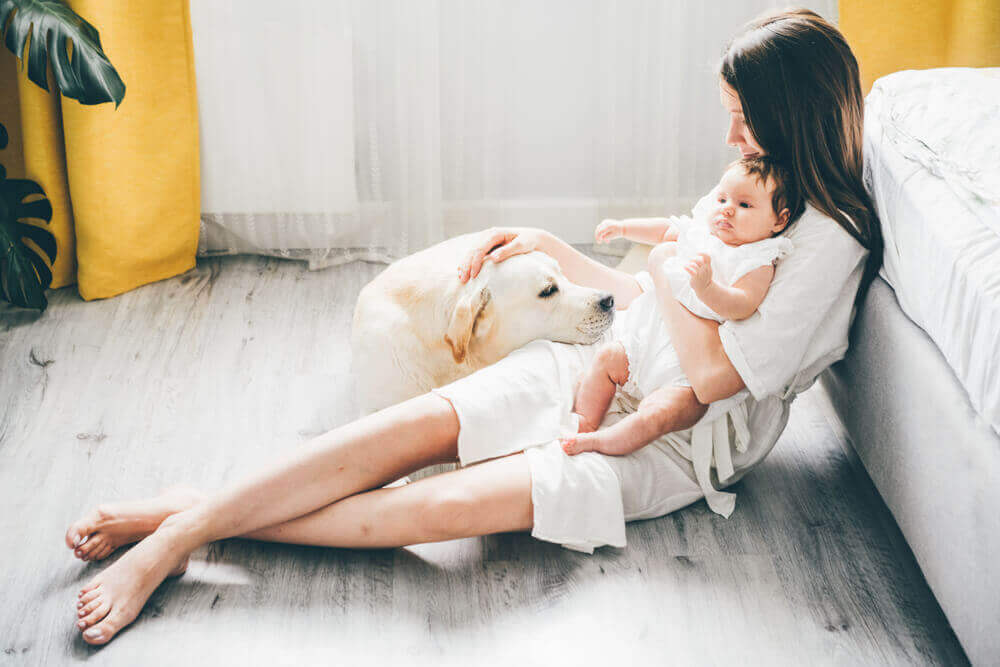
If you have a baby and want to add a dog to your family
Adding a dog to your family can bring joy to everyone. According to the Center for Disease Control and Prevention (CDC) “Studies have shown that the bond between people and their pets can increase fitness, lower stress, and bring happiness to their owners.”
They also remind pet parents that dogs can pass germs to humans. This is especially true with young children and babies whose immune systems are just beginning to develop.If you have a dog or are thinking about adding one to your family and you have young children, it is important to teach them about propper handwashing after playing with the pup.
While it’s unlikely that your pup will get the whole family sick, there are other things to consider. Like, will you have time to devote to raising a young child and training or assimilating a dog into your family? Dogs require a lot of attention and care. One of the primary reasons dogs find themselves in shelters is because the owners underestimated the amount of time they’d need to devote to training and caring for a dog.
If you are an experienced dog owner or you do decide to take the plunge and get a dog when you have a baby in the house, introduce the dog and baby slowly. Never leave your child unsupervised with your new pet.
There is nothing quite like the bond between a child and their dog. Make sure you teach your child to respect your dog and treat them well and you will all be rewarded with a lifetime of unconditional love from your best friend.
Expect the unexpected
No matter what advice we give you here, we won’t be able to prepare you for any and all situations. Whether your dog loves the baby like one of their own puppies, is completely indifferent to the baby in the house, or is very leery, something will happen along the way to make you scratch your head.
Remember to keep your eye on everyone – including the dog and be prepared for anything that might come up. If you need extra help, be sure to reach out to your vet or an experienced trainer.
Also, remember that you’re only human and doing the best you can to keep a new baby, your dog and yourself alive. It’s hard work.
The Ollie blog is devoted to helping pet parents lead healthier lives with their pups. If you want to learn more about our fresh, human-grade food, check out MyOllie.com.
Tagged As:

The nutrition your dog needs,
the food they want.

Enjoying our articles? Subscribe our Newsletters and get new articles directly to your inbox
You might also like
23 September 2025
6 MINS READ
Back to School: Training Your Dog at Any Age
As we hit back-to-school season rolls around, it’s not just kids who benefit from sharpening their skills and learning something new—our dogs can, too! Training isn’t limited to puppies or p…
by Ollie Pets
23 September 2025
7 MINS READ
Lace Up and Leash Up: A Beginner’s Guide to Running with Your Dog
Running is one of the simplest ways to stay active, and it’s even better with a canine companion. Not only does running with your dog keep you both in great shape, it also strengthens your bond …
by Ollie Pets
13 May 2025
8 MINS READ
Puppy Training Guide & Behavior Timeline
Bringing home a puppy is pure magic. It’s also pure chaos—tiny teeth, zoomies, accidents in the house, and moments that make you wonder if you’re raising a future genius or a tiny tornado. …
by Ollie Pets
